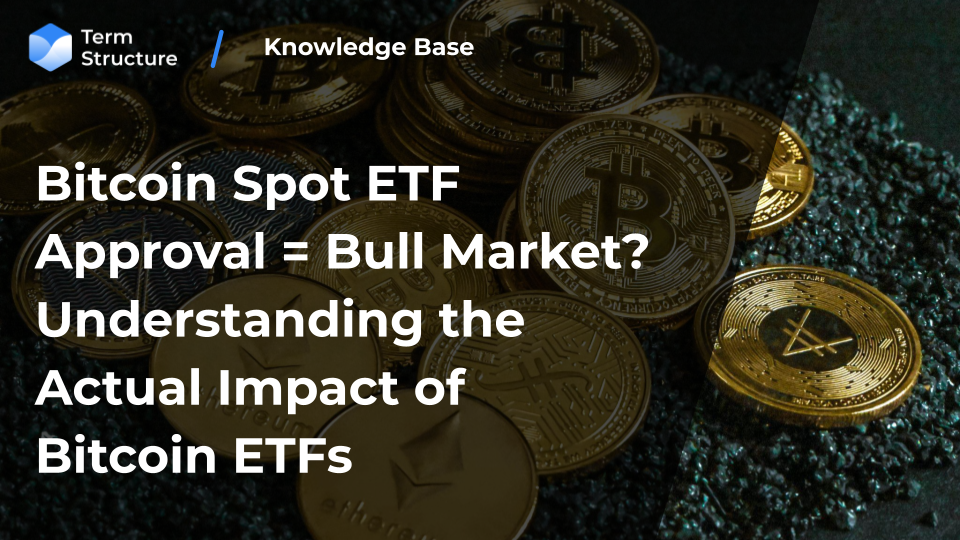Bitcoin Spot ETF Approval = Bull Market? Understanding the Actual Impact of Bitcoin ETFs

Introduction
In the past month, bitcoin's price has soared by an astonishing 30%. The recent surge in price can largely be attributed to the growing excitement about the potential approval of a bitcoin spot exchange-traded fund (ETF) by authorities in the United States. Indeed, the crypto community is eagerly anticipating the influx of capital from traditional finance (TradFi) following the listing of bitcoin spot ETFs on stock exchanges.
This excitement, however, might not be entirely justified because TradFi funds have been entering the crypto market via bitcoin futures and bitcoin futures ETFs. In other words, the approval of spot bitcoin ETFs in the U.S. does not necessarily attract new TradFi funds that would drive up bitcoin prices. In contrast, long-term investors, such as asset management companies and individuals concerned about slippage in bitcoin futures, tend to favor bitcoin spot ETFs. This preference has the potential to impact Bitcoin prices. In this article, we will explain the structure of ETFs, analyze how TradFi funds can enter the crypto market via both spot and futures ETFs, and discuss how investments from asset management firms and retail investors can affect Bitcoin price after the approval of bitcoin spot ETFs.
ETF Basics and Structure
Before explaining how TradFi funds are channeled into the crypto market via ETFs, it is important to understand their structure first.
An ETF's creation involves four key players: an index company, an ETF issuer, an authorized market maker (an authorized participant), and an exchange where the ETF is traded. Typically, an ETF would mirror the performance of a benchmark index created by the index company. ETF issuers pay for access to this essential index data and strive to maintain a high correlation between the ETF and the index’s performance as much as possible. ensuring the ETF accurately reflects the index's performance.
To become an authorized market maker, entities must obtain authorization from the ETF issuer. These market makers are entitled to either subscribe to or redeem the ETF directly from the issuer. Authorized market makers benefit from their unique position, which allows them to participate in market-making and arbitrage trading. For example, if a spot bitcoin ETF gets approved, they can use their bitcoins to buy the ETF directly from the issuer. Likewise, they can also redeem their spot bitcoin ETF for bitcoins.
Understanding the Influx of TradFi Funds into Crypto via Spot Bitcoin ETFs
We will use a diagram to analyze how funds from TradFi can make their way into the crypto market through spot bitcoin ETFs. For simplicity, let us assume that each unit of a spot bitcoin ETF is equivalent to the value of one bitcoin. Typically, the price of the ETF aligns with the spot price of bitcoin. However, any discrepancy between the prices of the bitcoin ETF and spot bitcoin can incentivize market makers to implement specific trading strategies.
When TradFi institutions begin subscribing to spot bitcoin ETFs, their prices tend to climb. As a result, the difference between the prices of a spot bitcoin ETF and bitcoin widens. As the ETF's price increases, market makers will start selling ETFs. If all the available ETFs are sold out and still fail to meet the market demand, the price of the bitcoin ETF will continue to rise. Eventually, it could reach a level where market makers see an opportunity to profit through arbitrage trading.
How Market Makers Engage in Arbitrage
We can see in the diagram that the price of the spot bitcoin ETF is $33,000, while the price of bitcoin is $30,000. In this scenario, the market maker will spend $30,000 to buy bitcoin and subscribe to spot bitcoin ETF from the issuer. This market maker will then sell the ETF on the exchange for $33,000, earning a price difference of $3,000. Market makers use the above process to arbitrage, and selling the newly issued spot ETFs on the market can also put downward pressure on the prices of an ETF.
When there is a significant demand for bitcoin, market makers will purchase as much bitcoin as possible and then subscribe to ETFs. This action, in turn, drives up the price of bitcoin. It is evident that the directional relationship of bitcoin and a spot bitcoin ETF in an arbitrage depends on the amount of capital from TradFi entering the crypto market via ETFs.
As the funds flowing into the bitcoin spot ETF decrease and market makers gradually stop arbitraging, the ETF price and bitcoin price will move to a new equilibrium, thus eliminating arbitraging opportunities. If the new price is higher, it suggests that the ETF issuance has increased due to a rise in market makers' arbitrage activities. Conversely, if the new price is lower, it indicates a reduction in ETF issuance due to a fall in market makers' arbitrage activities.
Based on the explanation above, it is clear that a spot bitcoin ETF can indeed increase the price of bitcoin. Yet, a spot bitcoin ETF alone is unlikely to significantly boost bitcoin prices because TradFi funds have already been entering the crypto market through bitcoin futures ETFs.
How Funds From TradFi Is Entering the Crypto Market Through Bitcoin Futures ETFs
Next, we will use a diagram to illustrate how TradFi capital has been flowing into the futures ETF. We will introduce futures market prices, including both long and short prices, to help readers better understand the transmission mechanism.
Since the underlying assets of futures ETFs are futures contracts, market makers will buy futures contracts and subscribe to futures ETF shares from the issuers.
When market makers long a bitcoin futures ETF, its price will increase. This will ultimately narrow the spread between futures prices and futures ETF prices to eliminate arbitrage opportunities.
Investors who participate in both the bitcoin futures and spot markets often seize arbitrage opportunities when they notice a significant difference between futures and spot prices. If a significant amount of TradFi capital flows into the bitcoin futures ETFs, the futures prices will surpass spot prices. To capitalize on this situation, investors can sell bitcoin futures and buy bitcoin. Buying bitcoins in the spot market also contributes to an increase in bitcoin prices.
Eventually, the arbitrage opportunities among futures, spot, and ETF prices will disappear. The absence of arbitrage opportunities does not mean there is no price difference among these three. Rather, it simply means the difference is so small that market makers and investors have no incentive to arbitrage.
At this point, it is clear that TradFi funds do not necessarily need spot ETFs to enter the crypto market. Hence, the approval of spot bitcoin ETFs might not significantly boost Bitcoin prices.
Retail Investors and Asset Managers Could Be Interested in Spot Bitcoin ETFs
Long-term investors, such as retail investors and asset managers, prefer spot bitcoin ETFs to futures bitcoin and futures bitcoin ETFs due to worries about the potential slippage in futures trading. Slippage refers to the difference between the expected price of a trade and the price at which the trade is executed. In the volatile bitcoin futures market, this can result in significant losses, particularly for large trades. By contrast, bitcoin spot ETFs directly track the current market price of bitcoin, offering a more accurate reflection of its real-time value. This reduces the risk of slippage and makes spot ETFs a more stable and predictable investment for those with a long-term horizon. Moreover, spot ETFs simplify the investment process because they do not require the management of rolling futures contracts, which can be complex and cost-intensive, especially for individual investors. That said, if Bitcoin spot ETFs were approved, retail investors and asset managers would likely increase their allocation to bitcoin as part of their investment portfolios. This would provide them with a more direct and efficient exposure to bitcoin's price movements, without the complexities and potential risks associated with futures contracts. As retail investors and asset managers add bitcoin to their investment portfolio, bitcoin prices will be influenced.
Conclusion
In conclusion, while the introduction of spot bitcoin ETFs could potentially boost Bitcoin prices, it is important to note that TradFi funds have already entered the crypto market through bitcoin futures and bitcoin futures ETFs. Therefore, we must closely monitor the real impact of spot bitcoin ETFs on bitcoin prices to gauge their true influence. Looking ahead, we can expect to see a range of new trading tools that connect TradFi with crypto. These new instruments typically open up fresh avenues for capital to flow in and out. Regulatory changes could also significantly influence the movement of capital. It is essential to pay close attention to these factors as they will play a vital role in the future financial landscape.

